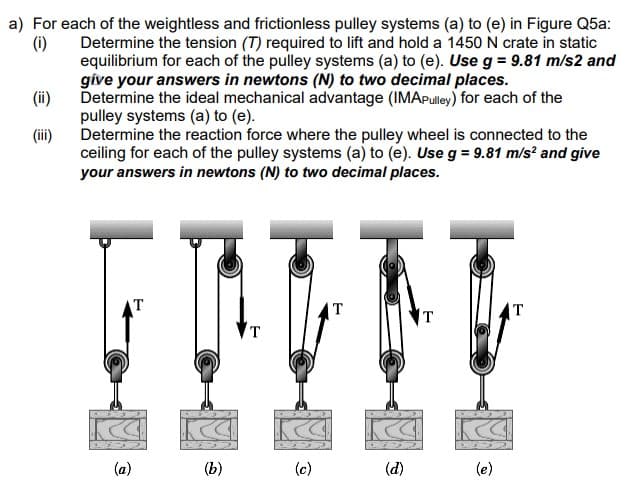(i) a) For each of the weightless and frictionless pulley systems (a) to (e) in Figure Q5a: Determine the tension (7) required to lift and hold a 1450 N crate in static equilibrium for each of the pulley systems (a) to (e). Use g = 9.81 m/s2 and give your answers in newtons (N) to two decimal places. Determine the ideal mechanical advantage (IMAPulley) for each of the pulley systems (a) to (e). (ii) (iii) Determine the reaction force where the pulley wheel is connected to the ceiling for each of the pulley systems (a) to (e). Use g = 9.81 m/s² and give your answers in newtons (N) to two decimal places. 3 T (b) T Ⓡ T (d) T Ⓡ T
(i) a) For each of the weightless and frictionless pulley systems (a) to (e) in Figure Q5a: Determine the tension (7) required to lift and hold a 1450 N crate in static equilibrium for each of the pulley systems (a) to (e). Use g = 9.81 m/s2 and give your answers in newtons (N) to two decimal places. Determine the ideal mechanical advantage (IMAPulley) for each of the pulley systems (a) to (e). (ii) (iii) Determine the reaction force where the pulley wheel is connected to the ceiling for each of the pulley systems (a) to (e). Use g = 9.81 m/s² and give your answers in newtons (N) to two decimal places. 3 T (b) T Ⓡ T (d) T Ⓡ T
Physics for Scientists and Engineers: Foundations and Connections
1st Edition
ISBN:9781133939146
Author:Katz, Debora M.
Publisher:Katz, Debora M.
Chapter6: Applications Of Newton’s Laws Of Motion
Section: Chapter Questions
Problem 10PQ: A makeshift sign hangs by a wire that is extended over an ideal pulley and is wrapped around a large...
Related questions
Question

Transcribed Image Text:a) For each of the weightless and frictionless pulley systems (a) to (e) in Figure Q5a:
Determine the tension (T) required to lift and hold a 1450 N crate in static
equilibrium for each of the pulley systems (a) to (e). Use g = 9.81 m/s2 and
give your answers in newtons (N) to two decimal places.
(i)
Determine the ideal mechanical advantage (IMAPulley) for each of the
pulley systems (a) to (e).
(ii)
(iii)
Determine the reaction force where the pulley wheel is connected to the
ceiling for each of the pulley systems (a) to (e). Use g = 9.81 m/s² and give
your answers in newtons (N) to two decimal places.
(a)
(b)
T
(c)
T
(d)
T
(e)
T
Expert Solution
This question has been solved!
Explore an expertly crafted, step-by-step solution for a thorough understanding of key concepts.
Step by step
Solved in 3 steps with 3 images

Knowledge Booster
Learn more about
Need a deep-dive on the concept behind this application? Look no further. Learn more about this topic, physics and related others by exploring similar questions and additional content below.Recommended textbooks for you

Physics for Scientists and Engineers: Foundations…
Physics
ISBN:
9781133939146
Author:
Katz, Debora M.
Publisher:
Cengage Learning

Physics for Scientists and Engineers, Technology …
Physics
ISBN:
9781305116399
Author:
Raymond A. Serway, John W. Jewett
Publisher:
Cengage Learning

Physics for Scientists and Engineers: Foundations…
Physics
ISBN:
9781133939146
Author:
Katz, Debora M.
Publisher:
Cengage Learning

Physics for Scientists and Engineers, Technology …
Physics
ISBN:
9781305116399
Author:
Raymond A. Serway, John W. Jewett
Publisher:
Cengage Learning